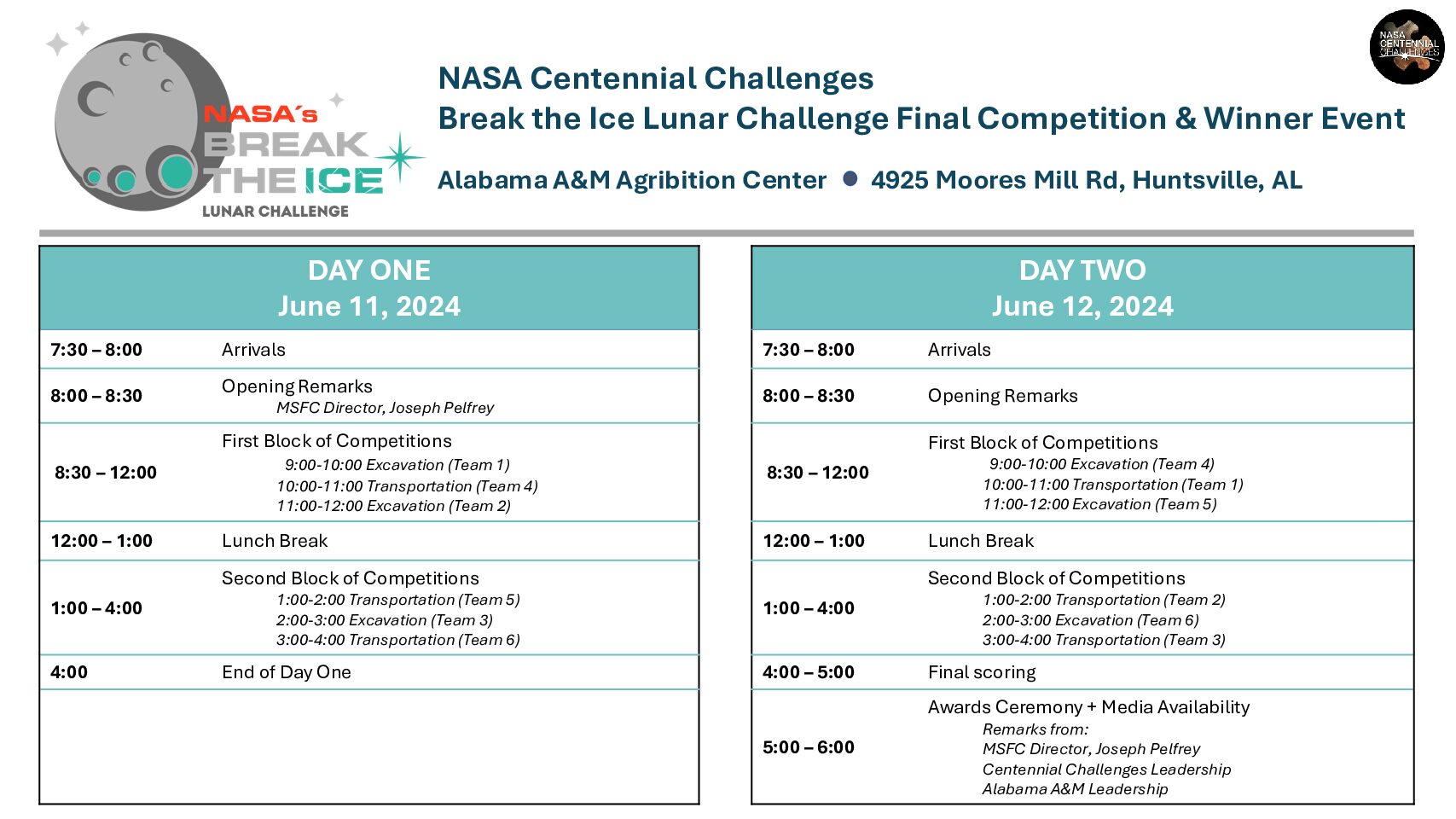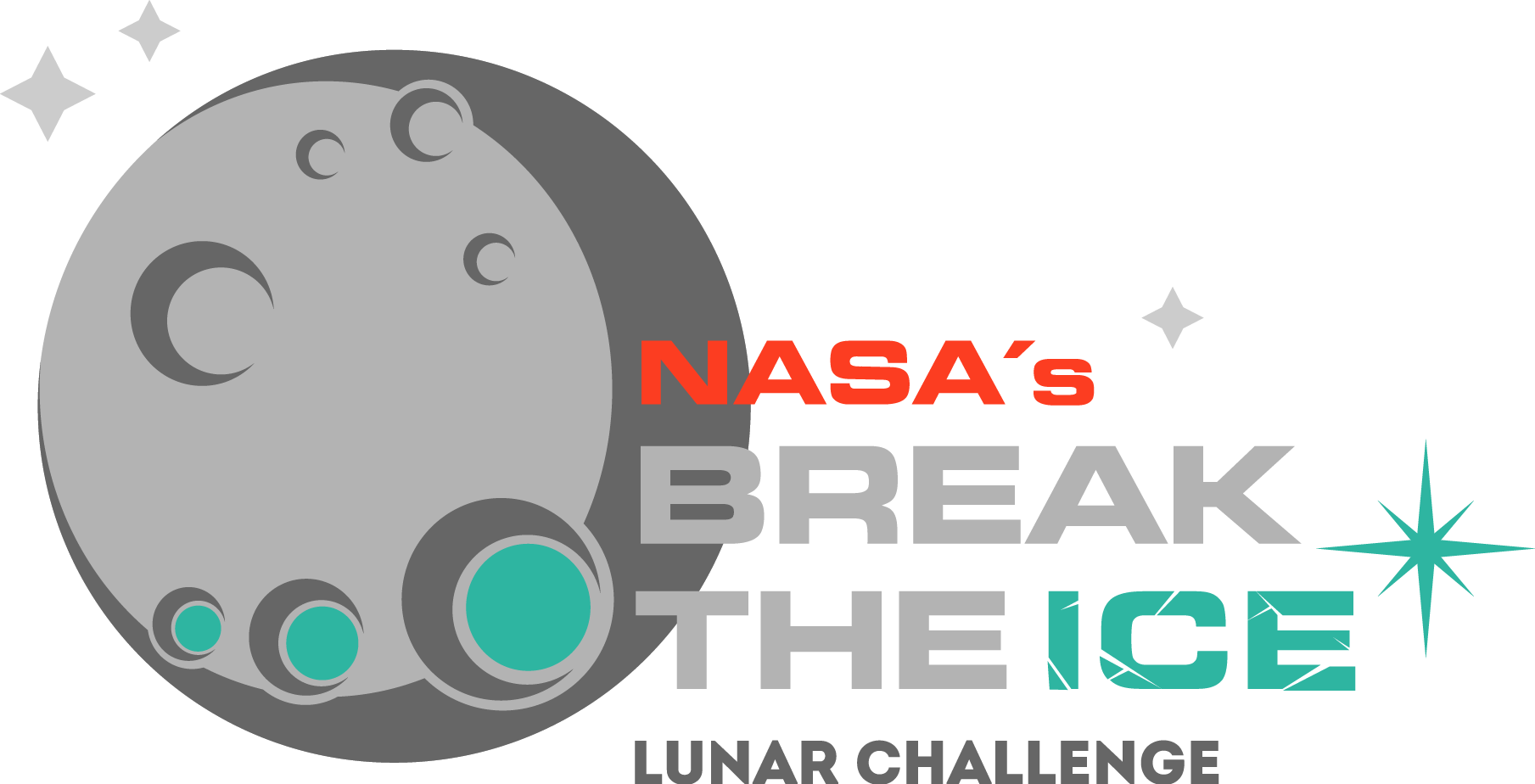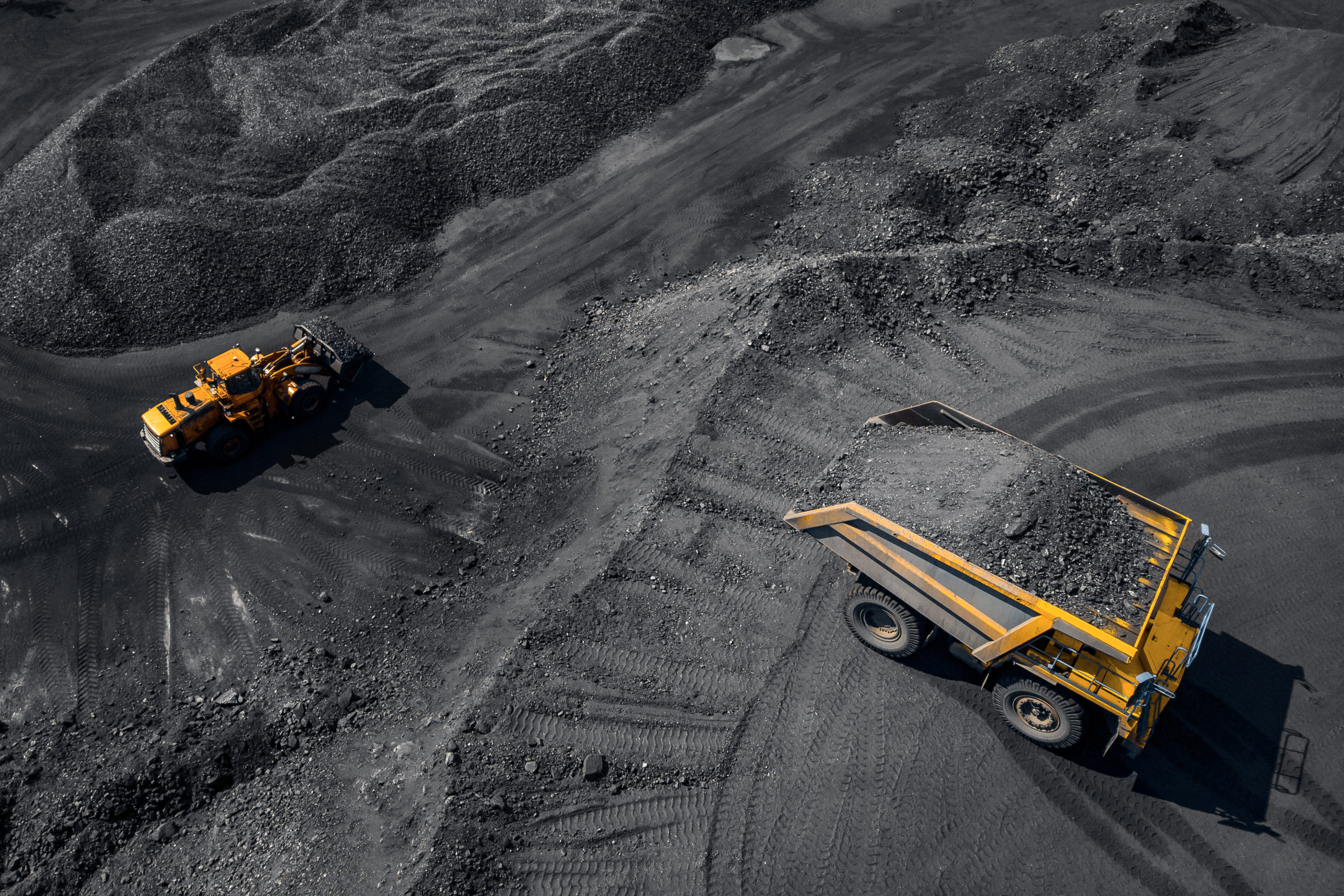Break The Ice Finals Scoring Rubric
(version 2, June 6, 2024)
The Break The Ice Finals Event encourages Teams to maximize excavation rates and to traverse rugged terrain, while minimizing landed system mass and minimizing energy usage.
The Excavation Events and Transportation Events will be executed and scored separately. The Excavation Event will be weighted more than the Transportation Event for calculating each Team’s overall Break The Ice Finals score. The weighting will be 60% for the Excavation Event and 40% for the Transportation Event.
Excavation Event
The goals of the Excavation Event are to:
- Maximize the ratio of the excavation rate to the landed system mass.
- Maximize the ratio of the excavation rate to the energy utilized.
Excavation Event Measured Values:
Mass of Robotic System MS
This is the mass of the Team’s robotic system measured during the event. See additional details in the Definitions section.
Mass Excavated ME
This is the mass of the excavated material onboard the excavation robot after it has achieved a “full payload” or the 60 minute timer runs out.
Excavation Time TE
This is the time it takes the excavation robot to achieve a “full payload” or 60 minutes maximum. See additional details, along with the penalty for not reaching stopping short of a “full payload,” in the Definitions section.
Excavation Energy EE
This is the energy used by the excavation robot during the above Excavation Time.
Excavation Event Calculated Values:
Mass Rate ME / TE
This is the rate of mass excavation. A larger Mass Rate is better than a smaller one.
Energy Rate EE / TE
This is the rate of energy utilization. A smaller Energy Rate is better than a larger one.
Mass Score Mass Rate / MS
This is the rate of excavation per system mass. A larger Mass Score is better than a smaller one.
Energy Score ME / Energy Rate
This is the mass excavated per power used. A larger Energy Score is better than a smaller one.
Event Score 60% Weighted Mass Score + 40% Weighted Energy Score This is the total score for the Excavation Event. See additional details in the Definitions section. A larger Event Score is better than a smaller one.
Excavation Event Scoring Examples:
Example 1: Single robot, excavates to capacity in less than one hour
- single excavation & transportation robot weighs 320 kg empty
- design basis payload capacity is 120 kg
- excavates 115 kg in 39 minutes
- uses 0.534 kWh of energy
MS = 320 kg
ME = 115 kg (within 90% of target, stopped-short penalty not applied) TE = 39 min or 0.65 hr
EE = 0.534 kWh
Mass Rate = 115 / 0.65 = 176.9 kg/hr
Energy Rate = 0.534 / 0.65 = 0.822 kW
Mass Score = 176.9 / 320 = 0.553 per hr
This score will be linearly shifted so that for all six robots competing, the robot with the highest mass score shifts to 60.
Energy Score = 115 / 0.822 = 139.9 kg/kW
This score will be linearly shifted so that for all six robots competing, the robot with the highest energy score shifts to 40.
Event Score = Weighted Mass Score + Weighted Energy Score
Weighted scores can only be calculated after all Teams have finished competing.
Example 2: Separate excavation & transportation robots, excavates for a full hour without reaching capacity
- excavation robot weighs 280 kg empty
- transportation robot weighs 110 kg empty
- design basis payload capacity is 220 kg
- excavates 180 kg in 60 minutes when time runs out
- uses 0.420 kWh of energy
MS = 280 + 110 = 390 kg
ME = 180 * 50% = 90 kg (stopped-short penalty does not apply since team did not claim to reach capacity and stop the clock)
TE = 60 min or 1.0 hr
EE = 0.420 kWh
Mass Rate = 90 180 / 1.0 = 90 180 kg/hr
Energy Rate = 0.420 / 1.0 = 0.420 kW
Mass Score = 90 180 / 390 = 0.231 0.462 per hr
This score will be linearly shifted so that for all six robots competing, the robot with the highest mass score shifts to 60.
Energy Score = 90 180 / 0.420 = 214.3 428.6 kg/kW
This score will be linearly shifted so that for all six robots competing, the robot with the highest energy score shifts to 40.
Event Score = Weighted Mass Score + Weighted Energy Score
Weighted scores can only be calculated after all Teams have finished competing.
Example 3: Multiple simultaneous robot architecture but only one robot competes, excavates to capacity in less than one hour
- first excavation & transportation robot weighs 380 kg empty
- second excavation & transportation robot weighs 370 kg empty ● design basis payload capacity for both robots is 70 kg
- one robot excavates 65 kg in 30 minutes
- one robot uses 0.380 kWh of energy
The multiple simultaneous robot architecture is unique for Break The Ice Finals scoring and is worthy of additional explanation.
Assume the architecture in this example was designed to perform 12 total 70 kg payload dig/drive/dump/drive cycles in a 6 hour workday. That gives them 840 kgs total delivered per day, which exceeds the 800 kg daily goal. Nominally, robot 1 will perform 6 dig/drive/dump/drive cycles during its 6 hour workday and robot 2 will also perform 6 cycles during its 6 hour workday. This means that each robot digs/hauls/dumps/hauls 70 kgs every hour for 6 hours and the entire system digs/hauls/dumps/hauls 140 kgs every hour for 6 hours.
During Break The Ice Finals, we are only allowing one robot from this system to actually dig under gravity off-load conditions. We are also allowing the Team members to stop the event timer as soon as the robot has filled its onboard hopper.
Since 140 kgs per hour is this architecture’s designed rate of excavation, it might seem appropriate to target that rate in the Excavation Event scoring rubric. It might seem appropriate that since the single competition robot dug for 30 minutes and collected 65 kgs, that we should then multiply the 65 kgs by 2 robots and to also multiply the 30 minutes of excavation time by 2 robots. That double multiplication would give this team a calculated competition excavation rate of 130 kgs per hour, which is a close match to their architecture’s designed excavation rate of 140 kgs per hour. Although this double multiplication appears fair when compared to the architecture’s designed excavation rate, it’s not actually fair for this particular scored event in general when we compare it against the approach we are applying to other (single robot excavation) cases.
For the excavation event, none of the other teams’ competition excavation rates are calculated to match or even come close to that architecture’s designed rate of excavation. For example, if another non-multiple-simultaneous robot team reaches their payload capacity of 100 kgs in only 30 minutes, then their calculated excavation rate for scoring is 200 kgs per hour, not 100 kgs per hour. Even though their architecture design might target only 100 kgs per hour, their calculated excavation rate used for Excavation Event scoring is focused on the excavation rate only during the time that was spent filling up their hopper to capacity. Their calculated excavation rate used for scoring is thus not intended to represent their architecture’s designed rate of excavation, but will reflect the robot’s performance in this specific event.
This means that all competing teams are essentially getting an excavation rate advantage in Break The Ice Finals which is different than, and likely greater than, their actual architecture’s designed excavation rate. Scoring for Break The Ice Finals Excavation Event does not take into account the driving, dumping, and returning operations that are accounted for in the architecture’s designed excavation rate. Scoring for Break The Ice Finals Excavation Event only focuses on excavation until the robot reaches capacity in an effort to score the Excavation Event performance independently.
This excavation rate advantage is not a problem as long as all teams are given this same advantage. This is why the scoring for the multi-simultaneous-robot architecture will take into account the landed mass of all the architecture’s robots. And it will multiply the mass excavated by a single robot by the number of robots. And it will also multiply the power used by a single robot by the number of robots. But it will NOT multiply the time one robot spent excavating by the number of robots.
MS = 380 + 370 = 750 kg (2 simultaneous robots in architecture)
ME = 65 * 2 = 130 kg (2 simultaneous robots in architecture)
TE = 30 min = 0.5 hrs (not doubled as explained above)
EE = 0.380 * 2 = 0.760 kWh (2 simultaneous robots in architecture)
Mass Rate = 130 / 0.5 = 260 kg/hr
Energy Rate = 0.760 / 0.5 = 1.52 kW
Mass Score = 260 / 750 = 0.347 per hr
This score will be linearly shifted so that for all six robots competing, the robot with the highest mass score shifts to 60.
Energy Score = 130 / 1.52 = 85.5 kg/kW
This score will be linearly shifted so that for all six robots competing, the robot with the highest energy score shifts to 40.
Event Score = Weighted Mass Score + Weighted Energy Score
Weighted scores can only be calculated after all Teams have finished competing.
Transportation Event
The goals of the Transportation Event are to:
- Maximize the ratio of the transportation rate to the landed system mass. ● Maximize the ratio of the transportation rate to the energy utilized.
- Encourage Teams to demonstrate their robot’s ability to traverse challenging terrain.
Shortcut Bonuses:
To achieve the goals of this event, three optional extreme shortcuts have been incorporated into the design of the transportation track. Each shortcut may be traversed in either or both directions of travel. Each shortcut successfully traversed during your full delivery leg, while fully loaded with your design basis payload capacity of material, will earn you a 10% Transportation Event score bonus. Each shortcut successfully traversed during your empty return leg will earn you a 5% Transportation Event score bonus. The maximum shortcut bonus possible for the Transportation Event involves successfully traversing all three in both directions which would earn you 10% + 10% + 10% + 5% + 5% + 5% for a maximum possible 45% total increase in your Team’s Transportation Event score.
Track Exit Penalty:
If any part of the transportation robot crosses the marked boundaries of the transportation course, the Team must command the robot back onto the transportation track without delay while minimizing the amount of time and distance spent outside of the marked course boundaries. Remember that the 60 minute event clock will not stop for any reason other than completing both legs of the course. If Judges determine that the Team’s time and/or distance utilized while returning their robot to the track has given them a scoring advantage, a penalty, as determined by the Judging Staff, will be applied to the Transportation Event score which is stronger than the scoring advantage that appeared to be gained.
Transportation Event Measured Values:
Mass of Robotic System MS
This is the mass of the Team’s robotic system measured during the event. See additional details in the Definitions section.
Mass Delivered MD
This is the payload mass as defined in the Team’s system architecture. An amount of material greater than or equal to the reported design basis payload capacity will be manually loaded and weighed on the transportation robot prior to the start of the event.
Transportation Time TT
This is the elapsed time for the robot to deliver its payload to the delivery area and return to the starting area of the track or 60 minutes maximum. See additional details and the penalty for not reaching the delivery area and returning in the Definitions section.
Transportation Energy ET
This is the energy used by the transportation robot during the above
Transportation Time.
Transportation Event Calculated Values:
Mass Rate MD / TT
This is the rate of mass transportation. A larger Mass Rate is better than a smaller one.
Energy Rate ET / TT
This is the rate of energy utilization. A smaller Energy Rate is better than a larger one.
Mass Score Mass Rate / MS
This is the rate of mass delivered per system mass. A larger Mass Score is better than a smaller one.
Energy Score MD / Energy Rate
This is the mass delivered per power used. A larger Energy Score is better than a smaller one.
Event Score 60% Weighted Mass Score + 40% Weighted Energy Score This is the total score for the Transportation Event. See additional details in the Definitions section. All earned Shortcut Bonuses will be applied to this Event Score. A larger Event Score is better than a smaller one.
Transportation Event Scoring Examples:
Example 4: Single robot, completes nominal course, no shortcuts, in less than one hour
- single excavation & transportation robot weighs 320 kg empty
- design basis payload capacity is 120 kg, team manually loads 122 kg onboard ● completes both delivery leg and return leg in 39 minutes
- uses 0.434 kWh of energy
MS = 320 kg
MD = 122 kg
TT = 39 min or 0.65 hr
ET = 0.434 kWh
Mass Rate = 122 / 0.65 = 187.7 kg/hr
Energy Rate = 0.434 / 0.65 = 0.668 kW
Mass Score = 187.7 / 320 = 0.587 per hr
This score will be linearly shifted so that for all six robots competing, the robot with the highest mass score shifts to 60.
Energy Score = 122 / 0.668 = 182.6 kg/kW
This score will be linearly shifted so that for all six robots competing, the robot with the highest energy score shifts to 40.
Event Score = Weighted Mass Score + Weighted Energy Score
Weighted scores can only be calculated after all Teams have finished competing.
Example 5: Separate excavation & transportation robots, completes course in less than one hour, completes extreme cross slope shortcut in both directions
- excavation robot weighs 280 kg empty
- transportation robot weighs 110 kg empty
- design basis payload capacity for transportation robot is 50 kg, team loads 54 kg onboard
- completes both delivery leg and return leg in 51 minutes
- completes extreme cross slope shortcut in both directions
- uses 0.680 kWh of energy
MS = 280 + 110 = 390 kg
MD = 54 kg
TT = 51 min or 0.85 hr
ET = 0.680 kWh
Mass Rate = 54 / 0.85 = 63.5 kg/hr
Energy Rate = 0.680 / 0.85 = 0.800 kW
Mass Score = 63.5 / 390 = 0.163 per hr
This score will be linearly shifted so that for all six robots competing, the robot with the highest mass score shifts to 60.
Energy Score = 54 / 0.800 = 67.5 kg/kW
This score will be linearly shifted so that for all six robots competing, the robot with the highest energy score shifts to 40.
Pre-Bonus Event Score = Weighted Mass Score + Weighted Energy Score Weighted scores can only be calculated after all Teams have finished competing. Post-Bonus Event Score = Pre-Bonus Event Score + (Pre-Bonus Event Score * (10% + 5%)) Apply 10% delivery leg score bonus plus 5% return leg score bonus.
Example 6: Multiple simultaneous robot architecture but only one robot competes, completes nominal course, no shortcuts, in less than one hour
- first excavation & transportation robot weighs 380 kg empty
- second excavation & transportation robot weighs 370 kg empty ● design basis payload capacity for both robots is 70 kg, team manually loads 75 kg onboard the competition robot
- one robot completes both delivery leg and return leg in 39 minutes ● one robot uses 0.290 kWh of energy
The multiple simultaneous robot architecture is unique for Break The Ice Finals scoring and is worthy of additional explanation.
Assume the architecture in this example was designed to perform 12 total 70 kg payload dig/drive/dump/drive cycles in a 6 hour workday. That gives them 840 kgs total delivered per day, which exceeds the 800 kg daily goal. Nominally, robot 1 will perform 6 dig/drive/dump/drive cycles during its 6 hour workday and robot 2 will also perform 6 cycles during its 6 hour workday. This means that each robot digs/hauls/dumps/hauls 70 kgs every hour for 6 hours and the entire system digs/hauls/dumps/hauls 140 kgs every hour for 6 hours.
During Break The Ice Finals, we are only allowing one robot from this system to actually compete in the Transportation Event. We are also allowing the Team members to stop the event timer as soon as the robot has completed a drive/dump/drive loop.
Since 140 kgs per hour is this architecture’s designed rate of delivery, it might seem appropriate to target that rate in the Transportation Event scoring rubric. It might seem appropriate that since the single competition robot ran for 39 minutes and delivered 75 kgs, that we should then multiply the 75 kgs by 2 robots and to also multiply the 39
minutes of transportation time by 2 robots. That double multiplication would give this team a calculated competition delivery rate of 150 kgs per hour which is a close match to their architecture’s designed delivery rate of 140 kgs per hour. Although this double multiplication appears fair when compared to the architecture’s designed delivery rate, it’s not actually fair for this particular scored event in general when we compare it
against the approach we are applying to other (single robot transportation) cases.
For the transportation event, none of the other teams’ calculated competition delivery rates are calculated to match or even come close to that architecture’s designed rate of delivery. For example, if another non-multiple-simultaneous robot team delivers 100 kgs in only 30 minutes, then their calculated delivery rate for scoring is 200 kgs per hour, not 100 kgs per hour. Even though their architecture design might target only 100 kgs per hour, their calculated delivery rate used for Transportation Event scoring is focused on the rate only during the time that was spent transporting material. Their calculated delivery rate used for scoring is thus not intended to represent their architecture’s designed rate of delivery, but will reflect the robot’s performance in this specific event.
This means that all competing teams are essentially getting a delivery rate advantage in Break The Ice Finals which is different than, and likely greater than, their actual architecture’s designed delivery rate. Scoring for Break The Ice Finals Transportation Event does not take into account the excavation operations that are accounted for in the architecture’s designed delivery rate. Scoring for Break The Ice Finals Transportation Event only focuses on material delivery and return in an effort to score the Transportation Event performance independently.
This delivery rate advantage is not a problem as long as all teams are given this same advantage. This is why the scoring for the multi-simultaneous-robot architecture will take into account the landed mass of all the architecture’s robots. And it will multiply
the mass delivered by a single robot by the number of robots. And it will also multiply the power used by a single robot by the number of robots. But it will NOT multiply the time one robot spent transporting by the number of robots.
MS = 380 + 370 = 750 kg (2 simultaneous robots in architecture)
MD = 75 * 2 = 150 kg (2 simultaneous robots in architecture)
TT = 39 min = 0.65 hrs (not doubled as explained above)
ET = 0.290 * 2 = 0.580 kWh (2 simultaneous robots in architecture)
Mass Rate = 150 / 0.65 = 230.8 kg/hr
Energy Rate = 0.580 / 0.65 = 0.892 kW
Mass Score = 230.8 / 750 = 0.308 per hr
This score will be linearly shifted so that for all six robots competing, the robot with the highest mass score shifts to 60.
Energy Score = 150 / 0.892 = 168.2 kg/kW
This score will be linearly shifted so that for all six robots competing, the robot with the highest energy score shifts to 40.
Event Score = Weighted Mass Score + Weighted Energy Score
Weighted scores can only be calculated after all Teams have finished competing.
In this example, shortcuts were not taken for simplicity. But any shortcuts that are successfully executed by the competing robot are assumed to also be successfully executed by the non-competing robot.
Example 7: Single robot, no shortcuts, transports for a full hour without finishing
- single excavation & transportation robot weighs 320 kg empty
- design basis payload capacity is 120 kg, team manually loads 123 kg onboard ● completes delivery leg
- during return leg, time runs out with robot 135 meters from end of track ● uses 0.480 kWh of energy
MS = 320 kg
MD = 123 kg
TT = 60 min or 1.0 hr
ET = 0.480 kWh
Mass Rate = 123 / 1.0 = 123 kg/hr
Energy Rate = 0.480 / 1.0 = 0.480 kW
Mass Score = 123 / 320 = 0.384 per hr
This score will be linearly shifted so that for all six robots competing, the robot with the highest mass score shifts to 60.
Energy Score = 123 / 0.480 = 256.3 kg/kW
This score will be linearly shifted so that for all six robots competing, the robot with the highest energy score shifts to 40.
Pre-Penalty Event Score = Weighted Mass Score + Weighted Energy Score Weighted scores can only be calculated after all Teams have finished competing. Non-Finishing Penalty = 135 / (amount driven + nominal distance remaining) Ratio of the distance remaining to the full track length, which includes both delivery leg and return leg, and accounts for any shortcuts actually taken.
Post-Penalty Event Score = Pre-Penalty Event Score – (Pre-Penalty Event Score * Non-Finishing Penalty)
Apply Non-Finishing Penalty.
Safety Violations
Throughout Break The Ice Finals, any judge or on-site safety representative may warn a Team of safety concerns and/or safety rule violations. Safety concerns and/or violations may include, but are not limited to, lack of appropriate Personal Protective Equipment (PPE) for the operation being performed or unsafe acts in general.
In addition to notifying the Team, safety concerns and/or safety rule violations will be documented and reported to the Head Judge. No penalty will be applied for the first instance of minor safety infractions. However, repeated minor safety infractions and/or any non-minor safety infractions will result in a penalty to that Team’s Overall Break The Ice Finals Event Score. The severity of the penalty will be based on the severity of the safety violation as determined by the Head Judge. The worst case penalty could be immediate disqualification from Break The Ice Finals.
Robot Modification Violations
As stated in NASA’s Break The Ice Lunar Challenge Phase 2 Competition Rules, in Level 3 Teams will bring the prototype systems they built and tested in Level 2 to a designated test facility to compete against other teams. Teams are allowed and encouraged, but not required, to make changes to their prototype excavation robots and prototype transportation robots before the
start of Break The Ice Finals. This is an opportunity to implement lessons learned from a Team’s Level 2 durability demonstration experiences. Changes to a Team’s Level 2 Phase 2 robotic system architecture are not permitted. For example, adding a new robot to the system is not allowed. Any modification to the robot(s) must continue to support a mission scenario of excavating and delivering 800 kg of icy-regolith every 24 hours for 15 days. For example, removing reinforcing brackets, heavy duty axles, etc. needed to support a 15 day mission is not acceptable.
All Break The Ice Finals Teams have submitted a Level 3 Event Modifications Report which describes all modifications that were made to the robotic systems which were used in their Phase 2 Level 2 Durability Demonstration Test.
All Level 3 Event Modifications Reports have been reviewed by Challenge Judging Staff, who have determined whether any Level 3 Event modifications impact the architecture’s ability to support a mission scenario of excavating and delivering 800 kg of icy-regolith every 24 hours for 15 days. For example, removing or reducing the weight of parts of a robot in an attempt to gain an unfair Level 3 scoring advantage was judged negatively. Reducing the weight of a robot was only judged positively if the Team’s Level 3 Modifications Report sufficiently justified that the modifications actually support the above mission scenario.
A subjective Event Modifications score is being developed and will be used to adjust each Team’s Overall Break The Ice Finals Event Score. If a Team makes no changes to their robot(s) for Level 3 or if a Team makes changes that do not impact the mission scenario, their Event Modifications score will be 100% and thus no deduction will be applied to that Team’s Overall Score. If judges evaluated that a Team has made changes to their robot(s) which would impact its ability to execute the mission scenario, the team will receive an Event Modifications score of less than 100% based on the level of the mission scenario impact. That Event Modifications score will be applied to adjust that Team’s Overall Score. The lowest allowable Event Modifications score will be capped at 70%.
During onsite robot inspections prior to scored Break The Ice Finals events, Challenge Judging Staff may apply additional Robot Modifications penalties if they notice any changes to a Team’s robots that impact the mission scenario and were not reported in that Team’s Level 3 Event Modifications Report.
Team Event Modification scores will be revealed only to the Team receiving that score, and will only be revealed after they have completed their required event inspections.
Overall Break The Ice Finals Event Score
As detailed earlier, the total score for the Excavation Event will have applicable penalties applied which relate to that event. Similarly, the total score for the Transportation Event will have applicable penalties and bonuses applied which relate to that event.
The overall Break The Ice Finals Event Score is made up of the weighted amounts of those two event scores, or 60% Weighted Excavation Event Score + 40% Weighted Transportation Event Score.
The earlier mentioned robot modification violation penalty and safety violation penalty, if applicable, will both be applied to this overall Break The Ice Finals Event Score before event winners are announced.
Definitions
Mass of Robotic System
This is the empty mass of the Team’s robotic system as measured during the event. This mass includes both the Team’s excavation robot and the Team’s transportation robot. If a Team uses the exact same robot for both operations, the mass value used for scoring is
the mass of this single robot. For Teams whose architectures contain multiple robots that work simultaneously, this mass includes the total weight of all robots. For the purposes of Break The Ice Finals scoring, the Mass of Robotic System does not include tools, spare parts, and repair equipment.
Excavation Time
This is the time between starting excavation under gravity off-load and determining that you have reached your design basis payload capacity as measured during the event. For Teams that do not achieve their published design basis payload capacity in one hour, their excavation time will be logged as 60 minutes. If a Team determines that they have reached capacity in less than one hour, they must inform the Excavation Event judge that their operations are complete and the judge will stop the event clock and record their Excavation Time. Teams are responsible for remotely determining if they have achieved their published design basis payload capacity. During the final weighing of robots that claimed to have reached capacity, if the weight of excavated material is less than 90% of their published design basis payload capacity, the Team will be strongly penalized for not reaching capacity and their measured Mass Excavated (ME) will be reduced by 50%.
Transportation Time
This is the time between starting in the starting area with a full payload, delivering that payload to the delivery area, and returning to the starting area as measured during the event. For Teams that fail to deliver their payload and return to the starting area in one
hour, their transportation time will be 60 minutes and a non-finishing penalty will be applied. This penalty will be based on the length of the standard driving route, without shortcuts, that remains to be traversed by the transportation robot when time runs out. The value of the penalty is the ratio of the distance remaining to the full track length, which includes both delivery leg and return leg.
Weighted Scores
The Weighted Score is the mathematical result of linearly shifting all Event Scores to raise or lower the entire field so that the highest score corresponds to a specific desired value. For example, in the Excavation Event, Mass Scores will be weighted so that the highest score becomes exactly 60 points, and Energy Scores will be weighted so that the highest score becomes exactly 40 points.
Here is an example of linearly shifting 6 example Team Mass Scores in order to shift the highest score to equal exactly 60 points:
Team Raw Weighted to 60
Team Alpha 0.3158 44.37
Team Beta 0.3791 53.27
Team Gamma 0.2982 41.90
Team Delta 0.4270 60.00
Team Epsilon 0.3855 54.17
Team Zeta 0.3295 46.30
The maximum score from the entire field is Team Delta at 0.4270. So Team Alpha’s weighted score is their raw score divided by the field’s max score and then multiplied by 60.
0.3158 / 0.4270 = 0.7396 * 60 or 74% of a full score of 60, or 44.37





